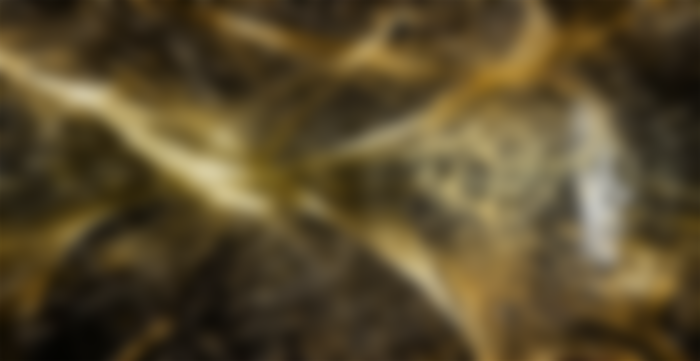
An astrophysicist from the University of Bologna and a neurosurgeon from the University of Verona recently carried out a relatively strange study: they compared the neural network of the human brain to the cosmic network of galaxies , to examine their respective structures. As it turns out, they highlighted several disturbing similarities.
As part of this study, published in the journal Frontiers in Physics , the two Italian researchers thus compared a simulation of the network of galaxies to sections of the cerebral cortex and the cerebellum. The objective was to observe how the fluctuations of matter disperse in each of these arrangements.
The human brain and the cosmic network of galaxies are arguably the two most complex systems in nature. Despite the enormous difference in scale between these two networks (more than 27 orders of magnitude separate them!), The quantitative comparison conducted by the two scientists suggests that the same physical processes could be at the origin of self-organization. of these structures, which today are of the same level of complexity.
The same structure, at two different scales
Our brain is made up of a vast network of approximately 86 billion neurons and almost the same number of non-neuronal cells. It consists of water (77−78%), fat (10−12%), protein (8%), carbohydrates (1%), soluble organic substances (2%) and salt (1% ). For its part, the observable Universe consists of a cosmic network of at least 2,600 billion galaxies. It is made up of about 73% dark energy, 22.5% dark matter, 4.4% ordinary baryonic matter, and less than 0.1% photons and neutrinos.
CBD could be an effective antibiotic against resistant bacteria
Thus, neurons and galaxies respectively constitute only a small portion of the mass / energy ratio of the brain and of the Universe: nearly 75% are only composed of a "passive" element, namely water in the brain. and dark energy in the Universe. In both systems, approximately 10 10 to 10 11 nodes are interconnected via filaments (neuronal and galactic) - considering as a "node" all galaxies of mass comparable or greater than the Milky Way.
To conduct their quantitative analysis, the researchers examined several independent samples of human cerebral and cerebellar cortex (4 μm sections). Their cosmological simulation produced a realistic and current distribution of dark matter, ordinary matter, and magnetic fields. At the highest magnification (x40) of the brain sections, the network of neural bodies and filaments showed some similarity to the cosmic web.

Left: a section of the cerebellum with a magnification factor of 40x, obtained by electron microscopy (Dr E. Zunarelli, University Hospital of Modena). Right: A cross section of a cosmological simulation, with an extension of 300 million light years on either side (Vazza et al. 2019 A&A). It is clear that the cosmic network and the neural network are alike… Credits: University of Bologna
To analyze the fluctuations of matter in either system, the scientists calculated the spectral density of each of them. " It is a technique often used in cosmology to study the spatial distribution of galaxies, " explains Franco Vazza. However, their analysis showed that the fluctuation within the brain - on a scale of 1 micrometer to 0.1 millimeter - followed the same progression as the distribution of matter in the cosmic network, which it extends from 5 million to 500 million light years.

Left: power spectra of density fluctuations in all samples. Right: Ditto with control power spectra for other (randomly drawn) samples of natural networks (clouds, tree branches, water turbulence and magneto-hydrodynamic turbulence), represented by gray lines. Here again, the similarity between the brain and the Universe is striking. Credits: F. Vazza and A. Feletti
The researchers also looked at other parameters characterizing the two systems, including the average number of connections for each node and the tendency for multiple connections to cluster around a major central node in the network. Here again, the resemblance was surprising. Which led the two colleagues to believe that the connectivity within these two networks was probably guided by identical physical principles. While the forces regulating galaxies and neurons are obviously completely different ...
A resemblance that could unravel some mysteries
The two researchers explain in their article that the human brain is a complex structure, on several temporal and spatial scales, in which cellular, molecular and neuronal phenomena coexist. It can be modeled as a hierarchical network, in which neurons group together into circuits, columns and different interconnected functional areas. This structure connects different areas of the brain, thus constituting the basis of cognition. Some of the major challenges for contemporary neuroscience are to disentangle this hierarchical network and to understand how complex cognitive functions are produced.
The Universe, on the other hand, seems to be reasonably well described by a "consensus" physical model called the ΛCDM ( Lambda Cold Dark Matter ) model, which takes into account gravity from ordinary matter and dark matter, expanding space-time described by general relativity, and antigravitational energy associated with empty space called "dark energy". The initial distribution of the density fluctuations of matter was amplified by the action of gravity and developed into larger clusters of galaxies, galactic filaments and voids, in all directions of space, forming a network on a large scale.
Among the main challenges that cosmology still faces today, remains to clarify the physical nature of dark energy, the composition of dark matter, the apparent tension between different measures of the rate of expansion of the Universe, or again the exact sequence of processes responsible for the variety of galaxy morphology and their co-evolution with supermassive black holes.
The discovery of so many similarities between the brain and the Universe could thus constitute a new avenue towards the resolution of the various mysteries which surround the one and the other system. " These two complex networks have more similarities between them than what one could observe between the cosmic network and a galaxy or between the neural network and a neuron ", summarizes Alberto Feletti. The researchers believe that these astonishing results could lead to new analytical techniques in the two fields - cosmology and neurosurgery - which will allow a better understanding of the dynamics underlying the temporal evolution of these two systems.


